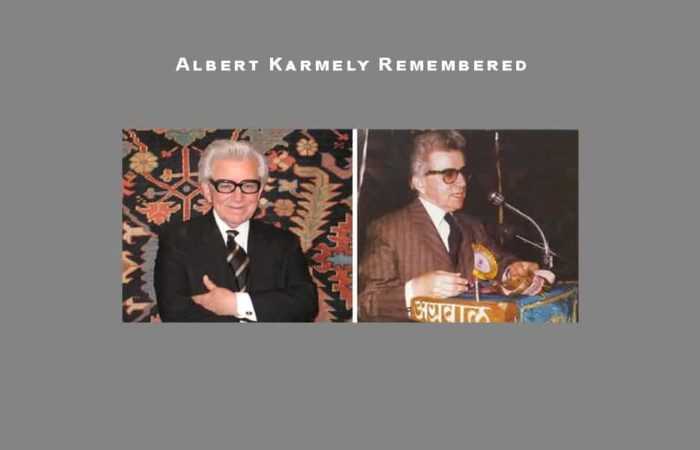Unraveling The Iconic Indo / Persian Chahar Bagh Layout Gardens and Area Rugs
Shop Persian Rugs | Shop Vintage / Modern Persian Rugs | Shop Antique Rugs | Shop Vintage Rugs | Shop Modern Rugs | Create Your Own Custom Area Rugs
Learn: The Complete History and Timeline of Persian Rugs
As you know, there are many different types of area rugs in the world. Many people are familiar with the terms “Persian rugs” or “Oriental rugs“. However, even withing specific types you can find even more specific groupings of area rug styles. As an example, the Chahar bagh rugs (Charbagh), or “garden rugs”, is term that is used to describe area rugs with a specific Persian style garden rug design layout. This specific rug design pattern has existed for thousands of years and is known as a favorite among collectors.
For starters – what does the word “Charbagh” mean?
The word “Chahar Bagh” also seen as “Chaharbagh” and “Charbagh” is a Farsi / Persian-derived term used in garden design and architecture to describe a specific type of formal garden layout. The word “Charbagh” is composed of two Persian words: “char” meaning “four” and “bagh” meaning “garden.”
A Charbagh garden is typically divided into four quadrants or sections by pathways or water channels that intersect at the center of the garden. These pathways and water channels create a symmetrical and geometric layout, often in the shape of a square or rectangle. The four quadrants are usually planted with flowers, trees, and other vegetation, and they may be further subdivided into smaller geometric patterns.
Charbagh gardens have historical roots in Persian and Islamic garden design and are often associated with Mughal architecture in the Indian subcontinent. They were used to create visually stunning and spiritually symbolic spaces. The layout of Charbagh gardens is intended to represent the Islamic concept of paradise on Earth, with the central intersection symbolizing the meeting point between the earthly and the divine.
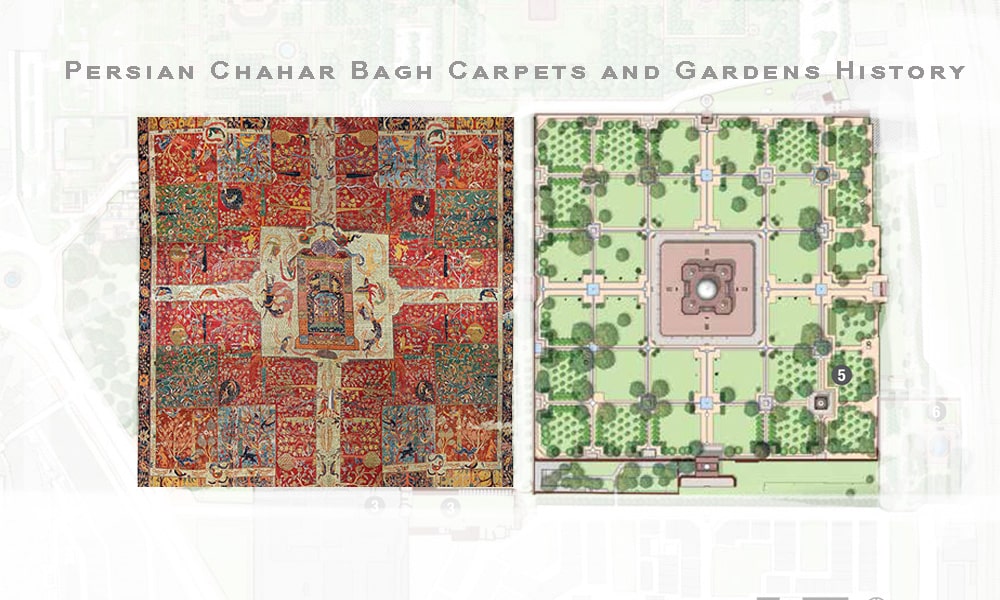
Persian Chahar Bagh Carpets and Gardens
Famous examples of Charbagh gardens include the gardens at the Taj Mahal in India and the Generalife Gardens in the Alhambra palace complex in Spain. These gardens are known for their exquisite design, symmetry, and integration of natural elements with human-made structures.
Origins Of the Chahar Bagh Rug Design
As noted above, the term “Chahar Bagh” translates literally to ‘four gardens.’ The layout and different parts of these rugs reflects a specific Iranian garden format. This garden form dominated the Persian garden scene from around 600 AD and can still be seen in the area today. However, the origins of Chahar Bagh actually date back to the mid-6th century BC in Cyrus the Great’s palace garden at Pasargadae.
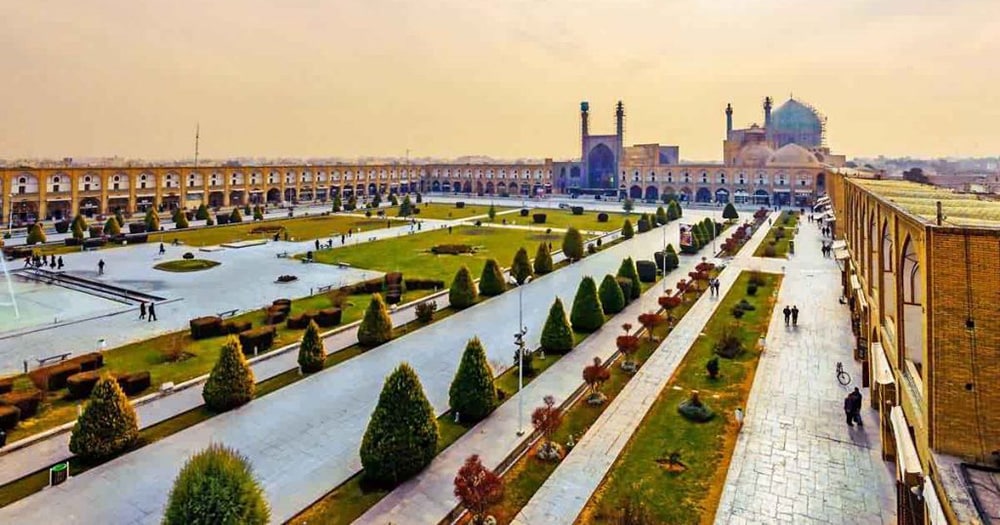
Charbagh Gardens At Naqshe Jahan Square In Isfahan Iran
Charbagh gardens focused on water and irrigation due to the arid climate of the area they originate from (present-day Iran). These layouts were geographic in nature, with strong symmetry. A fountain or water source would be located at the center of the garden, with the water separating into four different canals. These canals were designed in right angles and moved to divide the garden into four separate beds. These four beds represent four elements; sky, earth, plants, and water.
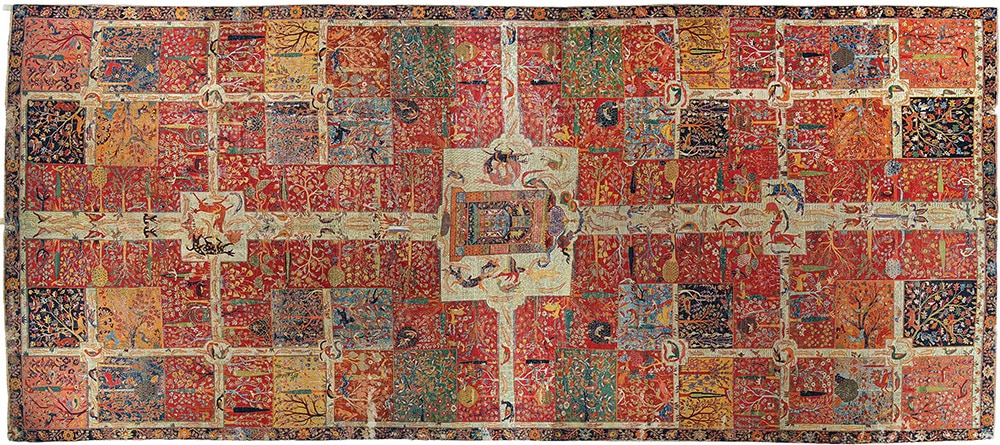
The Chahar Bagh Rug At The Albert Hall Museum In Jaipur
The Chahar Bagh Garden Form
The Chahar Bagh form spread rapidly throughout the eastern world until the 18th-century. Chahar Bagh gardens could be created anywhere, from a small courtyard to extensive royal palace grounds. Gardens with the four quadrant design can also be found over a vast distance, from Spain through the Middle East and India. As Persians and Muslims moved across Asia, the gardens were adapted to fit local needs, but the basic design features stayed the same.
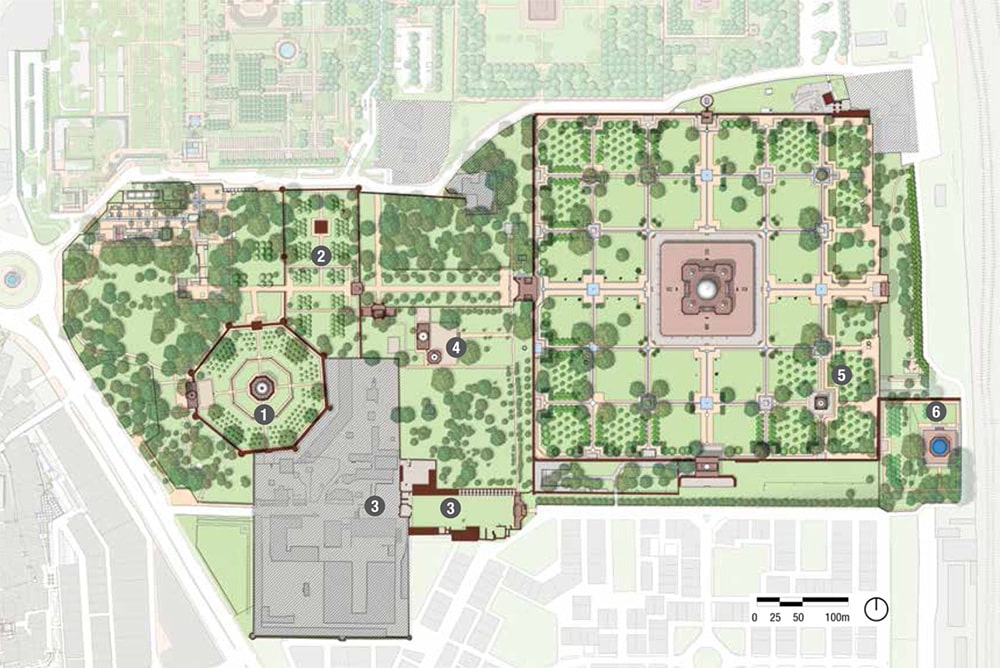
Chahar Bagh Garden Plan For Humayun’s Tomb
The spread of this garden layout and the spread of Islam went hand-in-hand. The four-garden designs were adopted by Muslim invaders, as they were viewed as a representation of the garden of Paradise (described in the Islamic holy book, the Qur’an). References are also made to a garden of Paradise, or Eden, in the Christian bible. This garden form’s symbolism has roots in three of the world’s larger religions – Islam, Hinduism, and Buddhism.

Charbagh Gardens of The Taj Mahal
Chahar Bagh as a Rug Pattern
The garden imagery, particularly the Chahar bagh area rug patterns and motifs, is well represented in Persian poetry and art. The Persian carpet weavers masterfully showed the Persian garden’s symmetry and beauty in their handwoven rugs.
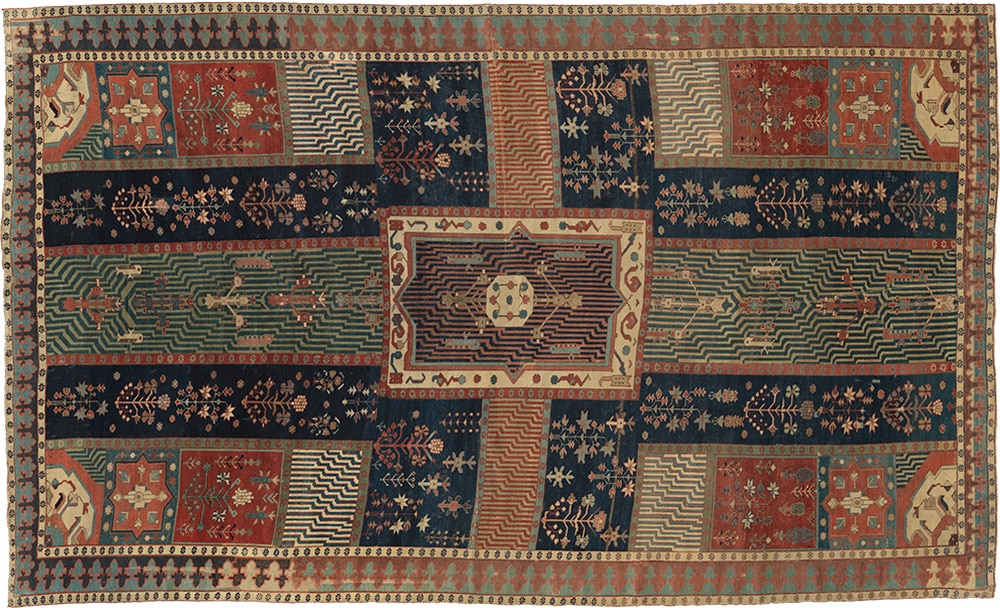
Char Bagh Rug At The Metropolitan Museum Of Art
Representations of Persian gardens in carpets combine a bird’s-eye view of the traditional four‑part garden with the addition of birds and trees. Garden rugs can be classified into three groups according to their designs:
4 Quadrant Chahar Bagh Rugs With Directional Landscapes with Trees
This group depicts dark tree imagery. This design’s variant is the Indian floral lattice group, which features a trellis-type design with several types of flowering trees, shrubs, and plants.
Example:

Chahar Bagh Four Quadrant Rug In The Victoria Albert Museum
Paradise Park Chahar Bagh Rugs
Figures of birds and animals are added into the landscape to create a “Paradise Park.”
Examples:
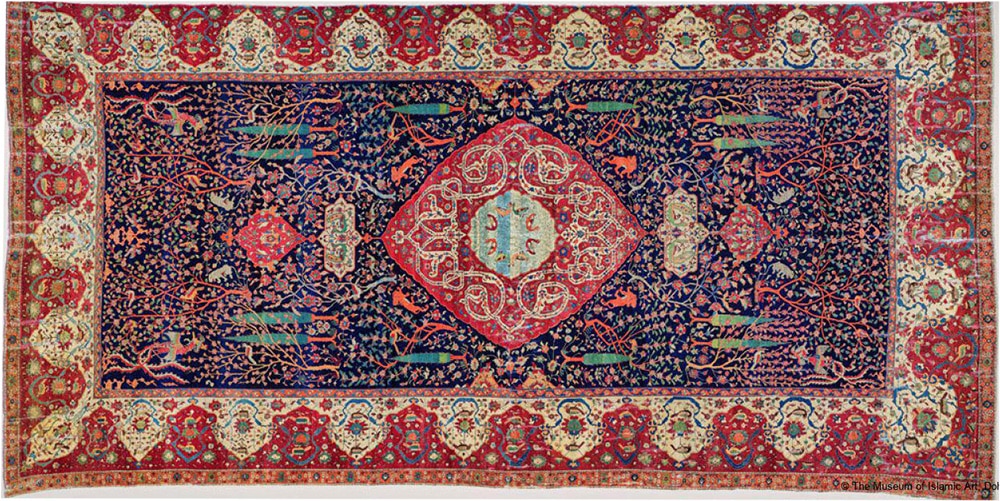
The Schwarzenberg Paradise Park Chahar Bagh Carpet Doha Islamic Art Museum

Center Of The Schwarzenberg Paradise Park Chahar Bagh Carpet Doha Islamic Art Museum
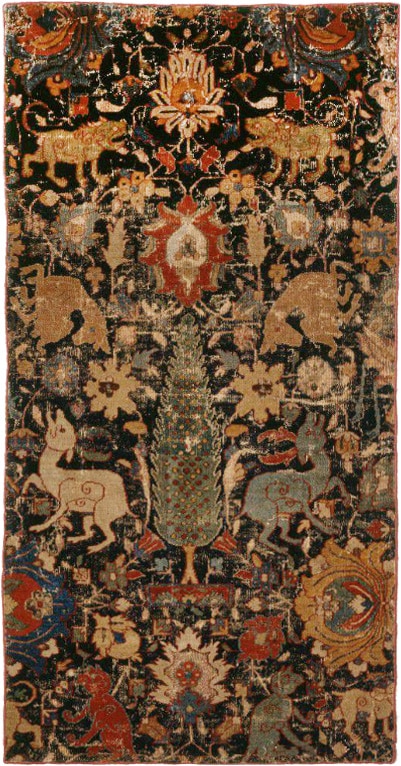
Chahar Bagh Paradise Park Design Safavid Fragment from the Montreal Museum Of Art
Formal Chahar Bagh Carpets
This design features a formal, walled garden separated by pathways and water canals into four (or more plots). These plots are filled with flowers, trees, and a variety of animals.
Example:
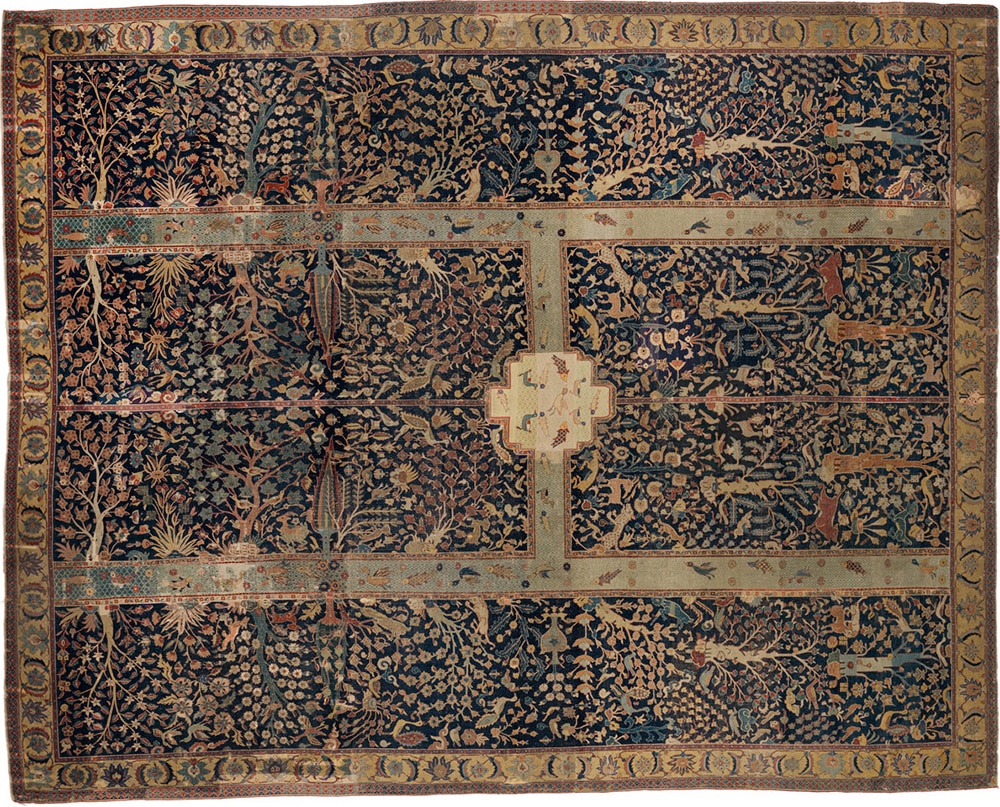
The Wagner Chahar Bagh Carpet In The Burrell Collection
The Antique Chahar Bagh Rugs
The earliest known references to a garden carpet are to the ‘Spring Of Khosrow Carpet,’ which was made for the 7th-century Sassanian emperor, Khusrow. This rug was rumored to be extremely large and very beautiful, crafted from silk, precious stones, and gold and silver threads. The Spring Carpet depicted a garden with trees, pathways, and blossoming flower beds.

A painted depiction of Khosrow I: The Lakhmid ruler Al-Mundhir III ibn al-Nu’man asking for Khosrow I’s assistance against the Byzantines.
Aside from the few distinct Safavid rugs of the late 16th/ early 17th-century, all other examples of this type of carpet were made during the 18th-century. These carpets were woven in wool on a cotton or wool foundation. All of these carpets were manufactured in workshops in northwest Kurdistan, but production died out by the early 19th-century. By the early 20th-century, there were only a small number of 18th-century Kurdish pieces still in existence.

Charbagh Gardens at Jahangir’s Tomb In Lahore India
In 1937, a Chahar bagh carpet was found in the Maharajahs of Jaipur’s abandoned palace at Amber Fort. Knotted in the Safavid way, this antique rug shockingly had records on a label attached to the lining and notes written directly on the lining itself. This inscription provided a short description of the carpet along with the date “29 August 1632.”
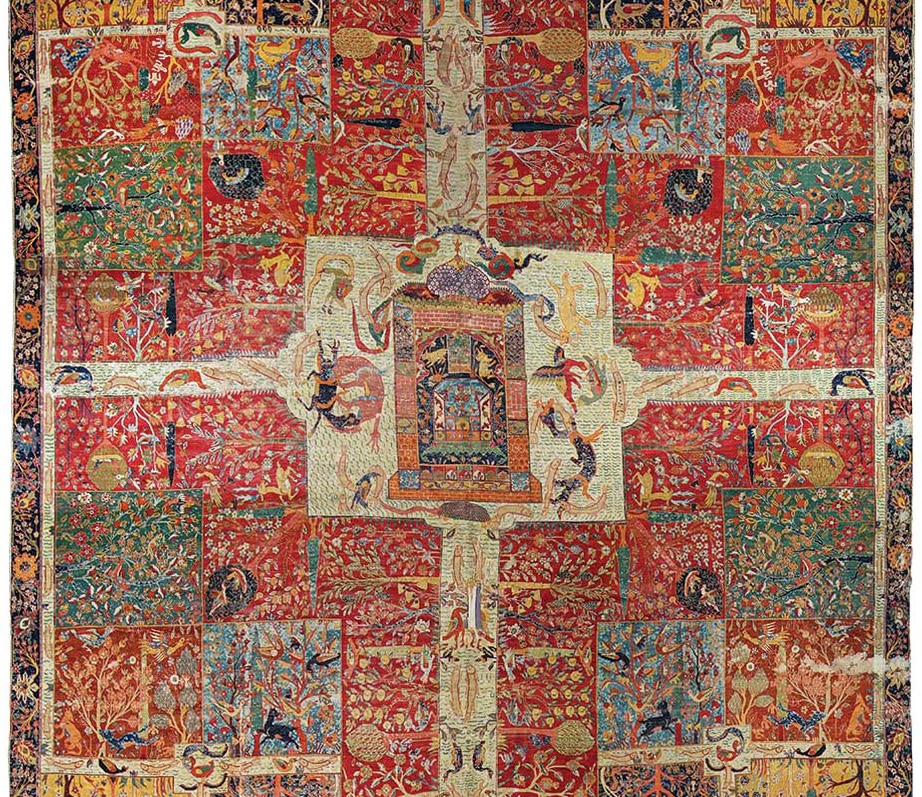
Detailed Image Of The Chahar Bagh Rug At The Albert Hall Museum In Jaipur
The Jaipur carpet is extremely large, stretching an impressive eight and a half meters long and almost four meters wide. It is extremely finely knotted and made from ivory cotton, fine wool in various colors, and blue and pink silk, which is only found in the best quality carpets. This carpet appears to be produced by a high caliber commercial workshop, most likely as a special order. As one of the oldest examples of this design, the Jaipur rug served as prototype for Kurdistan-based weavers.
This design and rug blog post about the iconic Indo-Persian Indo Persian Chahar Bagh Gardens and Rugs was published by Nazmiyal Rugs



